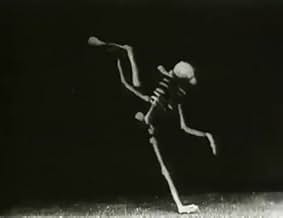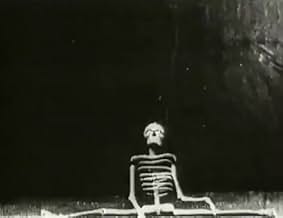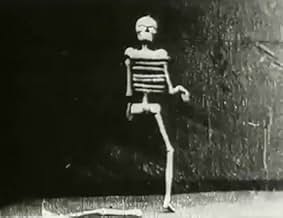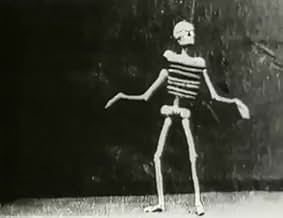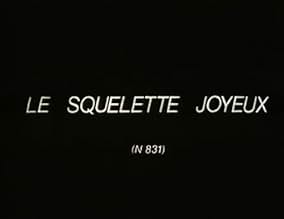Le squelette joyeux
- 1898
- 1min
PUNTUACIÓN EN IMDb
6,4/10
1,2 mil
TU PUNTUACIÓN
Añade un argumento en tu idiomaA skeleton dances joyously, often collapsing into a heap of bones and quickly putting itself back together.A skeleton dances joyously, often collapsing into a heap of bones and quickly putting itself back together.A skeleton dances joyously, often collapsing into a heap of bones and quickly putting itself back together.
- Dirección
Reseñas destacadas
What were supposed to, or else! A woman sits by a swamp thinking about what had happened before. She saw a mini purple object with a soul on a treadmill staring at a pucture of the crossed out sun. She had been entranced, and took a nap right there. The sun rose and kind of bleached here mind so she built a room full of warm water (with 0 entrance) out of play dough and set it next to the purple object. The purple object slowly turned its attention to the room, and basically ended up not looking away from it while moving on its machine. And..the woman stared at that with a blank face.
While this film is fascinating and delightful, it is absolutely not stop motion animation. It is a film of a "break apart" skeleton marionette, nothing more. I have a skeleton marionette made by the Pelham Puppets company that does all these tricks. Clearly the design for the marionette was around at the turn of the century, and Pelham mass-marketed it. I'm astonished that this film is widely regarded as "one of the first stop motion films", when it is nothing of the kind. That's all I have to say, but unfortunately the IMDb is insisting that my review isn't long enough, so I'm writing more words. The film itself is only 45 seconds long! How many words can one write about a 45 second film?
Honestly, this short subject was indeed made by the Lumiere Bros! Go ahead and laugh but it's true. Auguste and Louis Lumiere's films were often slices of everyday activities that will today be mostly of interest to film historians. Sometimes the Bros DID, however, create shorts that were staged just a bit, such as the primitive comedy "Tables Turned on the Gardener". But "The Joyeus Skeleton" is the closest I've ever seen the Bros get to the kind of filmmaking Georges Melies was turning out at the exact same time, not a trick film but certainly far from a documentary. It features a skeleton marionette (never mind that crud about it being stop-motion animation) dancing and flinging his bones around so that he falls apart. It is quite a clever idea and is interesting for the development of the Bros' films, and amazingly enough it's actually one of the few Lumiere films that can still entertain today. (If you wanna see it, many YouTube uploads have a fun music track that sounds like clacking bones which makes the watch more fun).
Le Squelette Joyeux (1898)
Long before Disney had THE SKELETON DANCE, there was this forty-second film from the Lumiere Brothers. Basically we see a skeleton (attached to wires) dancing around. As it dances faster and faster parts of it begin to fall off and then attach itself back to the body. This certainly isn't the work of Georges Melies but it's still pretty darn good and it's certainly very entertaining. It's obvious to see how the dance is being done but this really doesn't take away from the entertainment factor and especially when you consider when this was made. The goal was to make viewers laugh and I'm sure many did back in the day, although the sight of the skeleton might have scared some as well.
Long before Disney had THE SKELETON DANCE, there was this forty-second film from the Lumiere Brothers. Basically we see a skeleton (attached to wires) dancing around. As it dances faster and faster parts of it begin to fall off and then attach itself back to the body. This certainly isn't the work of Georges Melies but it's still pretty darn good and it's certainly very entertaining. It's obvious to see how the dance is being done but this really doesn't take away from the entertainment factor and especially when you consider when this was made. The goal was to make viewers laugh and I'm sure many did back in the day, although the sight of the skeleton might have scared some as well.
A common misconception is that motion pictures give the illusion of life; to the contrary, its illusion is one of death. Indeed, André Bazin, in "The Ontology of the Photographic Image," theorized cinema as mummification, a practice of embalming the dead. In traditional live-action cinema, life and motion is captured, made dead and still series of photographs, before being reanimated and projected on a screen like some grotesque Frankenstein monster--or a dancing skeleton. Lumière wasn't the first to realize this, either. For centuries before the Cinématographe was invented, there was the screen practice of the magic lantern, or "the lantern of fear," as it was otherwise known. Perhaps, the first such lantern slide, as illustrated by Christiaan Huygens in 1659, was of a skeleton given the illusion of macabre movement (see Laurent Mannoni's "The Great Art of Light and Shadow: Archaeology of the Cinema"). Later, a band of sequential images was given the illusion of motion by rapid succession via intermittent movement in Beale's Choreutoscope; the most famous of these are six images of a dancing skeleton (reprinted in Brian Coe's "The History of Movie Photography" and elsewhere). There was also Robertson's Phantasmagoria, which employed back-projected lantern slides moving on tracks to frighten spectators with approaching skeletons and other jump scares. It's appropriate, then, too, that when Disney further or re-popularized hand-drawn animation that the studio's first "Silly Symphony" should've been "The Skeleton Dance" (1929).
As for this Lumière film of the supposedly "cheerful" or "merry" "Dancing Skeleton," its also been misattributed as an early example of stop-motion animation, although I think it's rather obvious that it's a marionette (and it's labeled as such in the Lumière catalogue (398, vue no. 831)) worked by an unseen operator, which aptly was also the case with the Cinématographe. It's also something of a puzzle as to why such puppetry is ever classified as animation like the hand-drawn or even stop-motion sort. It's live-action cinematography of an inanimate, dead object animated in real time for the view of the camera--not still drawings or images brought to life only during projection. In that sense, this is akin to the actualities that make up most of the Lumière catalogue and is what distinguishes this "Dancing Skeleton" from some magic lantern precedents or the Disney cartoon. Unlike those from Huygens, Beale, Robertson and Disney, this skeleton once "lived" and danced before the Lumière Cinématographe captured and killed it, only for it, long after everyone involved in making it has since died and for more than a century since it was made, turned into a cinematographic ghost, continually reanimated, broken apart and put back together again and made to dance.
P.S. There's a third mistake that's been made across our present-day internet landscape regarding this film. There seems to have been two "Dancing Skeleton" films made in 1897 or 1898 (the Lumière film is listed as being programmed for a 20 March 1898 screening, but may've been photographed, if not released, earlier), one by Lumière and the other by the American Mutoscope Company, which the AFI catalog gives a release date of November 1897. Besides it or the Lumière film being cannibalized for AM&B's multiple-exposure trick film, "Davy Jones' Locker" (1900), the American Mutoscope film seems to be lost despite what some YouTube or Letterboxd posts might otherwise imply.
As for this Lumière film of the supposedly "cheerful" or "merry" "Dancing Skeleton," its also been misattributed as an early example of stop-motion animation, although I think it's rather obvious that it's a marionette (and it's labeled as such in the Lumière catalogue (398, vue no. 831)) worked by an unseen operator, which aptly was also the case with the Cinématographe. It's also something of a puzzle as to why such puppetry is ever classified as animation like the hand-drawn or even stop-motion sort. It's live-action cinematography of an inanimate, dead object animated in real time for the view of the camera--not still drawings or images brought to life only during projection. In that sense, this is akin to the actualities that make up most of the Lumière catalogue and is what distinguishes this "Dancing Skeleton" from some magic lantern precedents or the Disney cartoon. Unlike those from Huygens, Beale, Robertson and Disney, this skeleton once "lived" and danced before the Lumière Cinématographe captured and killed it, only for it, long after everyone involved in making it has since died and for more than a century since it was made, turned into a cinematographic ghost, continually reanimated, broken apart and put back together again and made to dance.
P.S. There's a third mistake that's been made across our present-day internet landscape regarding this film. There seems to have been two "Dancing Skeleton" films made in 1897 or 1898 (the Lumière film is listed as being programmed for a 20 March 1898 screening, but may've been photographed, if not released, earlier), one by Lumière and the other by the American Mutoscope Company, which the AFI catalog gives a release date of November 1897. Besides it or the Lumière film being cannibalized for AM&B's multiple-exposure trick film, "Davy Jones' Locker" (1900), the American Mutoscope film seems to be lost despite what some YouTube or Letterboxd posts might otherwise imply.
¿Sabías que...?
- CuriosidadesThe film is also known as "The Dancing Skeleton".
- ConexionesEdited into The Lumière Brothers' First Films (1996)
Selecciones populares
Inicia sesión para calificar y añadir a tu lista para recibir recomendaciones personalizadas
Detalles
- Fecha de lanzamiento
- País de origen
- Idioma
- Títulos en diferentes países
- The Dancing Skeleton
- Empresa productora
- Ver más compañías en los créditos en IMDbPro
- Duración
- 1min
- Color
- Mezcla de sonido
Contribuir a esta página
Sugerir un cambio o añadir el contenido que falta

